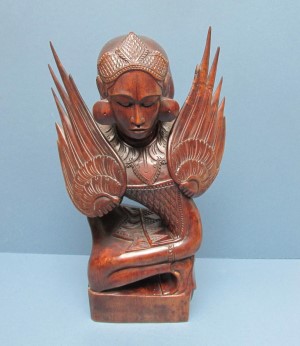
Wooden statue of a legong dancer
1930-1940
Magnificently carved statue of a legong dancer who performs the bird-dance, hence the arm pieces.
The most remarkable feature of this statue is the condition. It survived the long journey from Bali to Holland without damaging the wing tips. How many of these bird dancer statues were damaged? A good guess is probably more than 80%
If one takes a good close look at the wings they are not only razor thin but also carved in an angle, which is very hard to execute without breaking the wood.
The balinese carvers were known to specialise in a genre piece, which they mastered to perfection.
I once owned a similar bird dancer statue which was undoudtedly done by the same master. However that piece was badly damaged.
Pls click on the photo for more info&photos.
|
New

Woodcarving of a goat, made in prewar Bali by a anonymous artist.
1930-1940
|
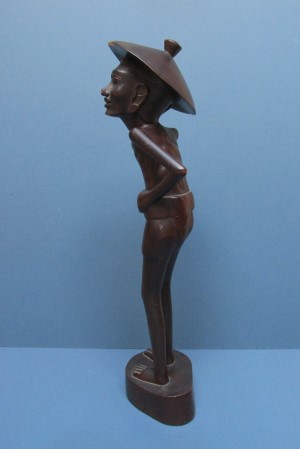
Woodcarving of a Balinese farmer.
Prewar folkart
1930-1940
Early statue, carved in the typical style of folk art. This carving can be compared with several carvings from the Helene Potjewijd collection, which are all from before 1936.
Pls click on the photo to see more photos&info.
|

Winged singha
1910-1940
Early carving which served as a base for a post. This base supported a pillar which supported a roof or bale bale, or other important building in a prewar Balinese village. Traces of polychromie(coloured paint) Old piece, probably around 1900-1910. Pls click on the photo to get more info and photos.
|

Rare bust of a Indonesian teenager.
1930-1960
Rare bust, probably made on Java, but Bali is possible too. The type of wood is unusual too. The density of the wood allows the carver greater detail, shown here in the facial features. Clicking on the photo will show more photos&info.
NFS; private collection
|

Charming bust of a young Indonesian girl
1930-1950
Excellent example of a very fine woodcarving technique. When more tourists came to Indonesia after the war, the demand for souvenirs increased considerably. Wooden busts were popular, because they had no protruding parts and were easy to take along in bags or suitcases. On Bali djanger busts became popular by the tourists and therefore mass produced. On Java the loro blonyo, a set of a female and a male bust, were popular as a gift to a newly wed couple. Single busts of a man or woman were less in demand, let alone single busts of young Indonesians. In that respect this bust is remarkable.
|
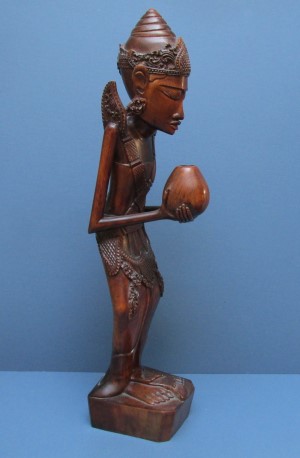
Balinese high priest with container for holy water
1930-1940
Excellent carving from the Pita Maha period(1928-1945). There are beautiful details, like the open-carved container and much detail to the fingers and feet of the priest. The elegant art deco lines are clearly visible. Carved in the expensive satinwood, only used by the best carvers of the village. Finished with a beautiful dark brown patina. Pls click on the photo to get more info and photos.
|

Small bust of an Indonesian woman with flowers in her hair.
1930-1950
Lovely small bust of an Indonesian woman with one remarkable feature; the broche in her hair on the backside.
It looks like the broche is made of djokja silver and therefore it may be carved in Java.
|
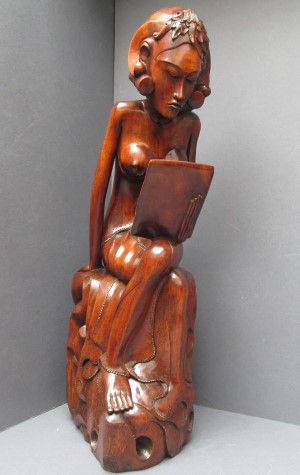
Sitting woman with mirror. Woodcarving from Bali, prewar
1930-1940
Impressive tall statue from the Pita Maha period(1928-1942). Striking elements are the beautiful deco lines that run downwards, and the vegetation-leave-motif on her head scarf. Copying is a normal and accepted thing in Bali, but for a copy you need the orginal. For all the ladies with mirror-carvings, this is probably the preferred original. Each photo can be enlarged two times by clicking on the image.
|

Mother and child. Wooden sculpture made on Bali.
1920-1930
Exceptional long carving (very rare!). Carved in Art Deco, a style that just became known on Bali at that time. A similar carving was exhibited during the exhibition "ART DECO ON BALI" in the Nusantara Museum in Delft (Holland) in 2005. It was published in a book accompanying the exhibition "Art Deco Sculptures From Bali 1930-1970" written by Frans Leidelmeier (page 69). Pls click on each photo to see two larger images.
|

Balinese woman with 3 birds. Wooden sculpture made on Bali in the thirties
1920-1930
Extremely long sculpture (very rare!) in a time that it became popular for balinese artists to create longer sculptures. Later a broader base was made to make the sculpture more stable. This statue must have been one of the first in his kind. Later it has been copied many times in all kinds of shapes and sizes. Pls click on each photo to see two larger images.
|
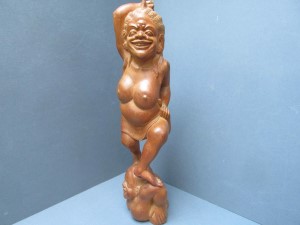
Wooden statue of the Hindu witch Rangda standing on one of her children.
1930-1940
Unusual 1930s-woodcarving of the witch Rangda, the personification of evil in the Hindu religion.
Rangda is often depicted as an old pregnant woman with long hair and an ugly face.
The meaning of Rangda standing on a child- may be related to an old Balinese folk-tale. Here Rangda wants her daughter Ratna Manggali to be married to an important person. However nobody wants to marry a daughter of a witch. Rangda takes that as an insult and wants revenge. She then goes to Durga, the demonical wife of Siwa and asks for advice. She advises her to go to the cemetery Gandamayu and dig up a body of a deceased child, which needs to be offered to Durga.
|

Wooden support, made on Bali in the 1930s.
1920-1940
Nicely carved wooden support, either used as a support for a pillar as part of a bale bale, or as a support for a holy statue.
|
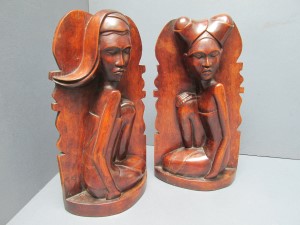
Wooden bookends, made on Bali period 1930-1950.
1930-1950
Odd pair of bookends.
The beautiful dark brown patina indicates an early production date.
These bookends have 2 unusual features; the man and woman stare right at you(normally the stare is subdued and pointed down). Also the head scarf of both is unusual. Maybe this set was made in a remote part of Bali, away from the tourist trail.
|
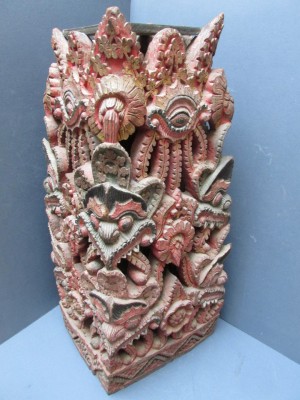
Woorden square support with fine woodcarving used in a bale bale
1920-1940
Nicely carved wooden support, either used as a support for a pillar as part of a bale bale, or as a support for a holy statue.
Pls click on the photo to get more info and photos.
|

Woodcarving of an old Bali priest
1920-1940
Very old and heavy carving of a Bali priest. He holds a flower and the priest bell (genta) with which he can perform religious acts.
Because of its seize and weight this carving could not be a souvenir item.
Probably it was made to decorate a temple.
|

Wooden statue of Garuda, made in Bali
1930-1940
Big and massive carving of Garuda, the holy bird from the Hindu religion.
This Garuda was part of an exhibition in Boston (USA) featuring the prewar art on Bali.
|

Garuda as temple guard
1930-1940
Impressive statue of Garuda, important figure in the Hindy mythology. This garuda is made by the same carver as the garuda of Tobo 298.
Remarkable is the fact that this statue has survived the transition from Bali to Holland better than the 298-item. Only some minor cracks. Over all in fine condition.
|
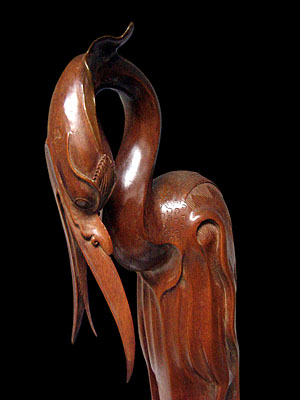
Bird with prey
1930-1940
Bird sculpture with strong art deco features. The twisted neck is very difficult to execute.
|
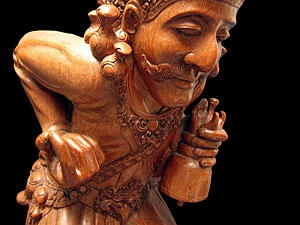
Bali priest with a bell
1940
Very large statue of a standing Bali priest, made before 1940. this is a carving not made for the tourists, since the size makes it unpractical to carry. Maybe this statue was made for a temple or it was a special order for a priest.
|

Bell/Gong, made in Java
1930-1940
Very nice detailed gong, carved in the famous jarapara style. the most remarkable thing is that the gong is completely intact. There isn't the slightest damage. Beautiful ornaments of floral patterns and wayang figures.
A similar gong can be found in the Nusantara Museum (Delft) and the Gemeente Museum in Den Hague.
Pls click on each photo to see two larger images.
|
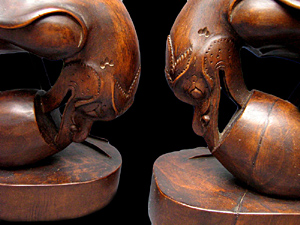
Bookends, in the shape of birds.
1930-1940
Birds bookends were a popular export product on Bali in the 1950s. Thousands were mass produced and that affected the quality considerably.
These bookends however were made before the mass production began. This is noticeble at two differences when compared to the more general bookends. First the beak of the bird goes into the egg instead of around it. Secondly the back support is bent slighly backward, just like a row of books would do. Normally the back support is placed under a 90 degrees angle. Also the beautiful brown patin is proof that these bookends were made in the thirties.
|
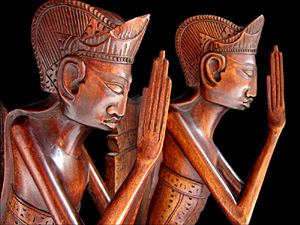
Wooden bookends made on Bali.
1930-1940
Nice pair of bookends, executed in the Art Deco style. This pair is slightly different than the other pair in the Tobo Art collection (TOBO-00018).
Pls click on each photo to see two larger images.
|

Wayang instruction-mould. Wood
A remarkable object used in a school or workshop for student learning the trade of woodcarving. In 5 stages the creation of a Wayang-head is shown. A missionary brought this piece to Holland.
|

Batak sculpture
1930-1942
Same kind of sculpture as TOBO-165 ,only this one is smaller. At the top a bird is depicted.
|

Rawana, the demon king from Ceylon, with Sita on his lap.
1930-1940
old carving depicting a scene from the ramayana story
|
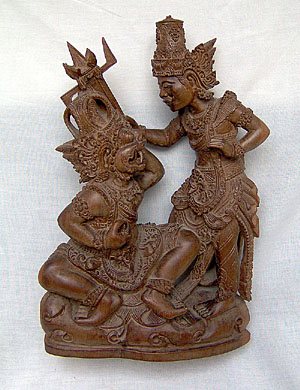
Scene from a mythologic story.
1940
|
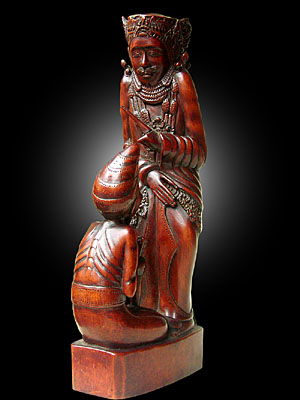
Wooden statue of a priest and his servant in the shape of a monkey.
1930
Magnificently carved statue of a somewhat mysterious scene. Probably it depicts a shiwa-priest with one of his servants, Baroeh in the shape of a monkey.
Pls click on each photo to see two larger images.
|
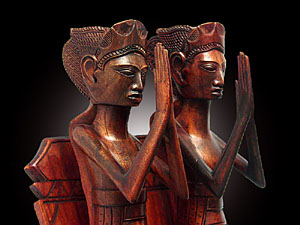
Bookends of praying men.
1930-1940
This is an important scene in Bali's daily life. from early morning to dawn the balinese bring offers in their houses and temples to please the good will of the gods. This motif has been used for these bookends.
Pls click on each photo to see two larger images.
|
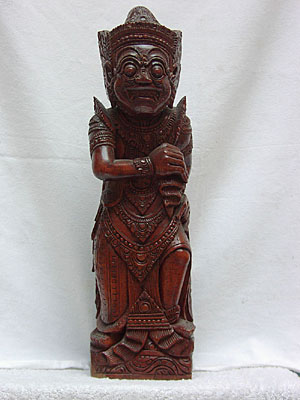
Temple guard.
1920-1930
Old sculpture probably made before 1930. In those times only sculptures like this were made for use in temples.
|